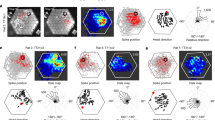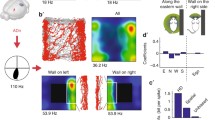Abstract
So far it is widely believed that mammalian navigation is based on map-like place representations created by hippocampal place cells. Models supporting this compute returning path to origin as a sequence of places, or as a sequence of firing place cells. However, these models often fail to compute the shortest returning path to start point. Moreover, one big constraint of these models is that the space has to be well explored to find a returning path from a certain endpoint. Here we propose a computational model for path integration and navigation based on Head Direction (HD) cells and grid cells. We show that an ensemble of HD cells can accumulate distance and compute the direction from the start point to the present location during exploration. Based on this vector navigation, and with the help of properties of grid cells in entorhinal cortex, it is possible to navigate the way back to the origin. We show that our recent model of rat entorhinal cortex provides these functional mechanisms of path integration and vector navigation.
Access this chapter
Tax calculation will be finalised at checkout
Purchases are for personal use only
Preview
Unable to display preview. Download preview PDF.
Similar content being viewed by others
References
O’Keefe, J., Dostrovsky, J.: The hippocampus as a spatial map. Preliminary evidence from unit activity in the freely-moving rat. Brain Res. 34, 171–175 (1971)
O’Keefe, J.: Place units in the hippocampus of the freely moving rat. Exp. Neurol. 51, 78–109 (1976)
O’Keefe, J., Nadel, L.: The Hippocampus as a Cognitive Map. Clarendon, Oxford (1978)
Muller, R.U., Kubie, J.L., Ranck Jr., J.B.: Spatial firing patterns of hippocampal complex-spike cells in a fixed environment. Journal of Neuroscience 7, 1935–1950 (1987)
Jung, M.W., McNaughton, B.L.: Spatial selectivity of unit activity in the hippocampal granular layer. Hippocampus 3, 165–182 (1993)
Hafting, T., Fyhn, M., Molden, S., Moser, M.B., Moser, E.I.: Microstructure of a spatial map in the entorhinal cortex. Nature 436, 801–806 (2005)
McNaughton, B.L., Battaglia, F.P., Jensen, O., Moser, E.I., Moser, M.B.: Path integration and the neural basis of the “cognitive map”. Nature Rev. Neuroscience 7, 663–678 (2006)
Islam, T., Yamaguchi, Y.: Representation of an Environmental Space by Grid Fields: A Study with a Computational Model of the Grid Cell Based on a Column Structure. In: Proceedings of IJCNN 2009 (2009)
Morris, R.G., Garrud, P., Rawlins, J.N., O’Keefe, J.: Place navigation impaired in rats with hippocampal lesions. Nature 297, 681–683 (1982)
Wilson, M.A., McNaughton, B.L.: Dynamics of the hippocampal ensemble code for space. Science 261, 1055–1058 (1993)
Kubie, J.L., Fenton, A.A.: Heading vector Navigation based on head direction cells and path integration. Hippocampus 19, 456–479 (2009)
Touretzky, D.S., Redish, A.D., Wan, H.S.: Neural representations of space using sinusoidal arrays. Neural Computation 5, 869–884 (1993)
Author information
Authors and Affiliations
Editor information
Editors and Affiliations
Rights and permissions
Copyright information
© 2010 Springer-Verlag Berlin Heidelberg
About this paper
Cite this paper
Islam, T., Fukuzaki, R. (2010). A Model of Path Integration and Navigation Based on Head Direction Cells in Entorhinal Cortex. In: Wong, K.W., Mendis, B.S.U., Bouzerdoum, A. (eds) Neural Information Processing. Theory and Algorithms. ICONIP 2010. Lecture Notes in Computer Science, vol 6443. Springer, Berlin, Heidelberg. https://doi.org/10.1007/978-3-642-17537-4_11
Download citation
DOI: https://doi.org/10.1007/978-3-642-17537-4_11
Publisher Name: Springer, Berlin, Heidelberg
Print ISBN: 978-3-642-17536-7
Online ISBN: 978-3-642-17537-4
eBook Packages: Computer ScienceComputer Science (R0)




